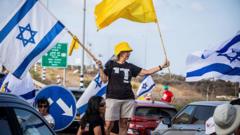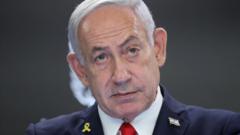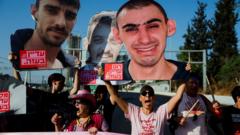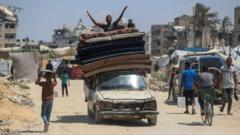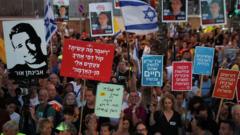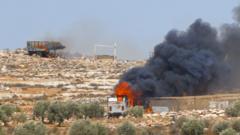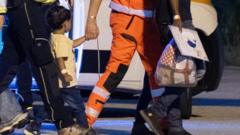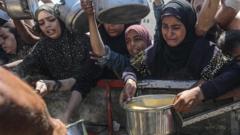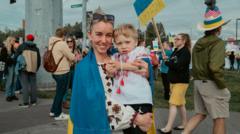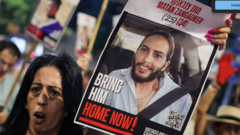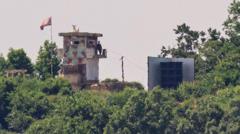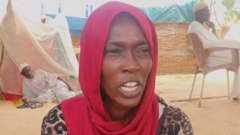In a dramatic move, Israel's military has announced the mobilization of approximately 60,000 reservists as part of comprehensive plans for a ground offensive aimed at capturing Gaza City. The mobilization, confirmed by military officials, is designed to bolster active-duty personnel already involved in operations in critical areas such as Zeitoun and Jabalia.
**Israel Mobilizes 60,000 Reservists in Anticipation of Gaza City Offensive**
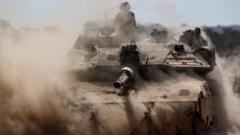
**Israel Mobilizes 60,000 Reservists in Anticipation of Gaza City Offensive**
Israel's military readiness escalates with a significant reserve mobilization amid intensifying conflict dynamics in Gaza City.
The offensive strategy receives backing from Defence Minister Israel Katz and is slated to be further discussed with the security cabinet later this week. As Israel prepares for this escalation, it has faced condemnation from international allies, alongside warnings from the UN and non-governmental organizations regarding a potential humanitarian crisis stemming from mass displacements and ongoing military actions, particularly following 22 months of conflict.
The increased military presence follows the breakdown of indirect negotiations with Hamas surrounds ceasefire terms and hostage releases, raising doubts about the prospects for peace. Regional mediators have proposed a new 60-day ceasefire plan, which includes the release of a portion of the 50 individuals still held hostage by Hamas. However, Israeli officials insist on a comprehensive agreement before any truce is achieved.
The Israel Defense Forces (IDF) have labeled this offensive as an extension of "Operation Gideon's Chariots," originally initiated in May. Plans indicate that five military divisions will partake in a meticulously coordinated operation within Gaza City. Katz stated that the operation aims to transform Gaza into a different landscape post-conflict, suggesting a significant redeployment of Gaza City's residents towards the southern regions for humanitarian needs, including food distribution and medical assistance.
The Prime Minister has reinforced the military's objective of securing hostage releases while decisively defeating Hamas. In tandem with these military actions, the IDF reported ongoing efforts to dismantle Hamas' military infrastructure in Jabalia and around Gaza City, while advising civilians to move south for their protection.
However, Palestinian officials have described the situation in Gaza City as critical, with sporadic shelling creating hazardous living conditions. A recent escalation of violence has reportedly resulted in civilian casualties, contributing to the widespread suffering across the region. Humanitarian agencies have denounced Israel's plans, predicting catastrophic consequences for the already vulnerable population, while emphasizing that southern Gaza lacks the capacity to effectively host the anticipated influx of displaced individuals.
Following the Hamas-led attack on October 7, which resulted in substantial casualties among Israelis, the conflict has intensified dramatically. Official reports indicate that over 62,000 Palestinians have died in the ongoing clashes, with a majority of Gaza’s population facing the dire consequences of displacement, infrastructure collapse, and imminent famine.
In light of the deteriorating humanitarian conditions, serious calls for peace negotiations and a reassessment of military strategies are increasing from international organizations and humanitarian groups. The upcoming weeks may prove crucial as the situation evolves rapidly amidst rising tensions and complex political dynamics in the region.
The increased military presence follows the breakdown of indirect negotiations with Hamas surrounds ceasefire terms and hostage releases, raising doubts about the prospects for peace. Regional mediators have proposed a new 60-day ceasefire plan, which includes the release of a portion of the 50 individuals still held hostage by Hamas. However, Israeli officials insist on a comprehensive agreement before any truce is achieved.
The Israel Defense Forces (IDF) have labeled this offensive as an extension of "Operation Gideon's Chariots," originally initiated in May. Plans indicate that five military divisions will partake in a meticulously coordinated operation within Gaza City. Katz stated that the operation aims to transform Gaza into a different landscape post-conflict, suggesting a significant redeployment of Gaza City's residents towards the southern regions for humanitarian needs, including food distribution and medical assistance.
The Prime Minister has reinforced the military's objective of securing hostage releases while decisively defeating Hamas. In tandem with these military actions, the IDF reported ongoing efforts to dismantle Hamas' military infrastructure in Jabalia and around Gaza City, while advising civilians to move south for their protection.
However, Palestinian officials have described the situation in Gaza City as critical, with sporadic shelling creating hazardous living conditions. A recent escalation of violence has reportedly resulted in civilian casualties, contributing to the widespread suffering across the region. Humanitarian agencies have denounced Israel's plans, predicting catastrophic consequences for the already vulnerable population, while emphasizing that southern Gaza lacks the capacity to effectively host the anticipated influx of displaced individuals.
Following the Hamas-led attack on October 7, which resulted in substantial casualties among Israelis, the conflict has intensified dramatically. Official reports indicate that over 62,000 Palestinians have died in the ongoing clashes, with a majority of Gaza’s population facing the dire consequences of displacement, infrastructure collapse, and imminent famine.
In light of the deteriorating humanitarian conditions, serious calls for peace negotiations and a reassessment of military strategies are increasing from international organizations and humanitarian groups. The upcoming weeks may prove crucial as the situation evolves rapidly amidst rising tensions and complex political dynamics in the region.

